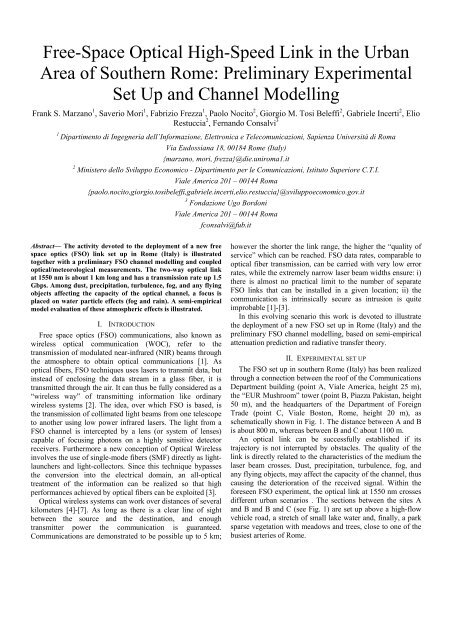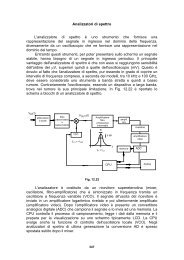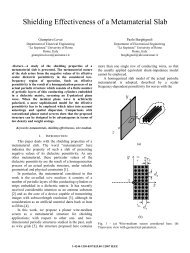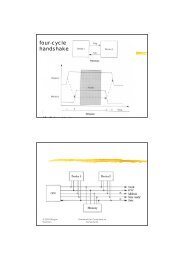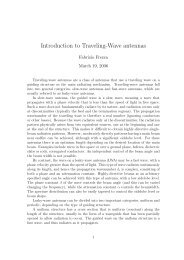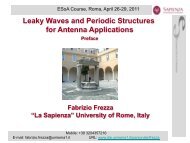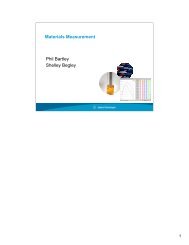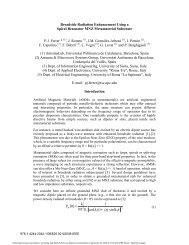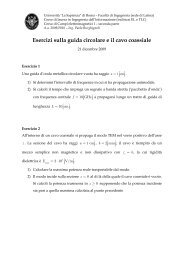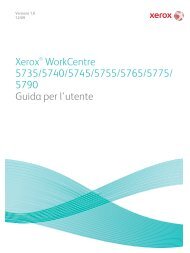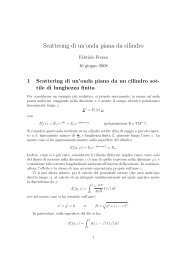FSO Proceedings of EuCAP2011 - Dipartimento di Ingegneria ...
FSO Proceedings of EuCAP2011 - Dipartimento di Ingegneria ...
FSO Proceedings of EuCAP2011 - Dipartimento di Ingegneria ...
Create successful ePaper yourself
Turn your PDF publications into a flip-book with our unique Google optimized e-Paper software.
Free-Space Optical High-Speed Link in the UrbanArea <strong>of</strong> Southern Rome: Preliminary ExperimentalSet Up and Channel ModellingFrank S. Marzano 1 , Saverio Mori 1 , Fabrizio Frezza 1 , Paolo Nocito 2 , Giorgio M. Tosi Beleffi 2 , Gabriele Incerti 2 , ElioRestuccia 2 , Fernando Consalvi 31<strong>Dipartimento</strong> <strong>di</strong> <strong>Ingegneria</strong> dell’Informazione, Elettronica e Telecomunicazioni, Sapienza Università <strong>di</strong> RomaVia Eudossiana 18, 00184 Rome (Italy){marzano, mori, frezza}@<strong>di</strong>e.uniroma1.it2 Ministero dello Sviluppo Economico - <strong>Dipartimento</strong> per le Comunicazioni, Istituto Superiore C.T.I.Viale America 201 – 00144 Roma{paolo.nocito,giorgio.tosibeleffi,gabriele.incerti,elio.restuccia}@sviluppoeconomico.gov.it3 Fondazione Ugo BordoniViale America 201 – 00144 Romafconsalvi@fub.itAbstract— The activity devoted to the deployment <strong>of</strong> a new freespace optics (<strong>FSO</strong>) link set up in Rome (Italy) is illustratedtogether with a preliminary <strong>FSO</strong> channel modelling and coupledoptical/meteorological measurements. The two-way optical linkat 1550 nm is about 1 km long and has a transmission rate up 1.5Gbps. Among dust, precipitation, turbulence, fog, and any flyingobjects affecting the capacity <strong>of</strong> the optical channel, a focus isplaced on water particle effects (fog and rain). A semi-empiricalmodel evaluation <strong>of</strong> these atmospheric effects is illustrated.I. INTRODUCTIONFree space optics (<strong>FSO</strong>) communications, also known aswireless optical communication (WOC), refer to thetransmission <strong>of</strong> modulated near-infrared (NIR) beams throughthe atmosphere to obtain optical communications [1]. Asoptical fibers, <strong>FSO</strong> techniques uses lasers to transmit data, butinstead <strong>of</strong> enclosing the data stream in a glass fiber, it istransmitted through the air. It can thus be fully considered as a“wireless way” <strong>of</strong> transmitting information like or<strong>di</strong>narywireless systems [2]. The idea, over which <strong>FSO</strong> is based, isthe transmission <strong>of</strong> collimated light beams from one telescopeto another using low power infrared lasers. The light from a<strong>FSO</strong> channel is intercepted by a lens (or system <strong>of</strong> lenses)capable <strong>of</strong> focusing photons on a highly sensitive detectorreceivers. Furthermore a new conception <strong>of</strong> Optical Wirelessinvolves the use <strong>of</strong> single-mode fibers (SMF) <strong>di</strong>rectly as lightlaunchersand light-collectors. Since this technique bypassesthe conversion into the electrical domain, an all-opticaltreatment <strong>of</strong> the information can be realized so that highperformances achieved by optical fibers can be exploited [3].Optical wireless systems can work over <strong>di</strong>stances <strong>of</strong> severalkilometers [4]-[7]. As long as there is a clear line <strong>of</strong> sightbetween the source and the destination, and enoughtransmitter power the communication is guaranteed.Communications are demonstrated to be possible up to 5 km;however the shorter the link range, the higher the “quality <strong>of</strong>service” which can be reached. <strong>FSO</strong> data rates, comparable tooptical fiber transmission, can be carried with very low errorrates, while the extremely narrow laser beam widths ensure: i)there is almost no practical limit to the number <strong>of</strong> separate<strong>FSO</strong> links that can be installed in a given location; ii) thecommunication is intrinsically secure as intrusion is quiteimprobable [1]-[3].In this evolving scenario this work is devoted to illustratethe deployment <strong>of</strong> a new <strong>FSO</strong> set up in Rome (Italy) and thepreliminary <strong>FSO</strong> channel modelling, based on semi-empiricalattenuation pre<strong>di</strong>ction and ra<strong>di</strong>ative transfer theory.II. EXPERIMENTAL SET UPThe <strong>FSO</strong> set up in southern Rome (Italy) has been realizedthrough a connection between the ro<strong>of</strong> <strong>of</strong> the CommunicationsDepartment buil<strong>di</strong>ng (point A, Viale America, height 25 m),the “EUR Mushroom” tower (point B, Piazza Pakistan, height50 m), and the headquarters <strong>of</strong> the Department <strong>of</strong> ForeignTrade (point C, Viale Boston, Rome, height 20 m), asschematically shown in Fig. 1. The <strong>di</strong>stance between A and Bis about 800 m, whereas between B and C about 1100 m.An optical link can be successfully established if itstrajectory is not interrupted by obstacles. The quality <strong>of</strong> thelink is <strong>di</strong>rectly related to the characteristics <strong>of</strong> the me<strong>di</strong>um thelaser beam crosses. Dust, precipitation, turbulence, fog, andany flying objects, may affect the capacity <strong>of</strong> the channel, thuscausing the deterioration <strong>of</strong> the received signal. Within theforeseen <strong>FSO</strong> experiment, the optical link at 1550 nm crosses<strong>di</strong>fferent urban scenarios . The sections between the sites Aand B and B and C (see Fig. 1) are set up above a high-flowvehicle road, a stretch <strong>of</strong> small lake water and, finally, a parksparse vegetation with meadows and trees, close to one <strong>of</strong> thebusiest arteries <strong>of</strong> Rome.
Fig. 1: I) <strong>FSO</strong> optical head; II) <strong>FSO</strong> site in southern Rome.Previous stu<strong>di</strong>es on the local micro-climate, withmeasurements made at the meteorological station located in A,confirmed the peculariatiy <strong>of</strong> the chosen site for urbanwireless communications experiments (see Fig. 2). The <strong>FSO</strong>experiment should last no less than two solar years, a period<strong>of</strong> interest from a scientific perspective.Fig. 2: Temperature and humi<strong>di</strong>ty histogram in Rome.The fSONA-SONAbeam ® 1250-E optical transceiverdevice has been recently installed in A and B (see Fig. 3). Itsmain characteristics are: weight <strong>of</strong> about 10 kg; structureoperating in the presence <strong>of</strong> wind gusts over 120 km/h andresistant to over 160 km/h; <strong>di</strong>mensions <strong>of</strong> 25×33×46 cm 3 ;power supply with 22÷57 VDC or 85÷260 VAC; safety withstandard IP66 (1550-nm is safe for human eyes); laser with 4transmitters <strong>of</strong> 160-mW peak power at 1550 nm; aperture<strong>di</strong>ameter <strong>of</strong> 20 cm; nominal maximum range in clear air up to5300 m; transmission rates (transparent and reclocked) up to1448 Mbs with transmission standards OC-3/STM-1, OC-12/STM-4, 270 Mbps, 1064 Mbps, Fast/Gig Ethernet.Together with the optical transreceiver, there will be alsoavailable at the site A: meteorological station (pressure,temperature, wind), raingauge, particle <strong>di</strong>sdrometer, opticalscintillometer, millimetre-wave ra<strong>di</strong>ometer, and visibilimeter.Fig. 3: fSONA-SONAbeam® 1250-E optical transceiver device.III. CHANNEL MODELLING<strong>FSO</strong> channel modeling requires to deal with the extinction<strong>of</strong> the laser beam power due to optical interactions withatmospheric particle <strong>di</strong>stributions, mainly aerosols, snow, fogand rain [5]. Only the latter two will be treated below. Ingeneral, the “extinction” law for any electromagnetic ra<strong>di</strong>ationintensity I (W m -2 sr -1 Hz -1 ) can be written as [8]:Irke( r')dr', 000 (0, r)r, I0,, e I e I t(0,r) (1)where r (km) is the range, () are the incidence angles, I 0 isthe incident intensity, k e (1/km) is the wavelength- andmeteorological-dependent extinction coefficient due toatmospheric gases and particle poly<strong>di</strong>spersions, the opticalthickness and t the intensity transmittance. The relation (1) isalso referred to as the “Beer–Lambert–Bouguer” law withinthe ra<strong>di</strong>ative transfer theory [8].A. Atmospheric attenuation due fog and rainThe main uncertainty to design an outdoor short-rangeoptical wireless link is the atmospheric attenuation, caused bythe absorption and scattering [5]-[7]. Water particles andcarbon <strong>di</strong>oxide mainly cause the absorption <strong>of</strong> optical signals,whereas fog, rain, snow and clouds cause the scattering <strong>of</strong>optical signals transmitted in free space. This scatteringprocesss causes the emitted light beam to deflect away fromthe intended receiver.Fog is the most deterrent attenuating factor for <strong>FSO</strong> links[6]. Fog causes significant path attenuation <strong>of</strong> optical signalsfor considerable amount <strong>of</strong> time due to the fact that the size <strong>of</strong>fog particles is comparable to the transmission wavelengths <strong>of</strong>optical and near infrared waves [7]. Optical attenuations incase <strong>of</strong> spherical fog droplets can be accurately pre<strong>di</strong>cted byapplying the “Mie scattering” theory [8]. The latter, however,involves requires a detailed information <strong>of</strong> fog parameters,like particle size, refractive index, particle size <strong>di</strong>stribution,which may not be available at a particular site <strong>of</strong> installation.An alternate approach is to pre<strong>di</strong>ct fog attenuation, basedon the visibility range information [9]-[12]. The visibilityrange r V is the <strong>di</strong>stance r to an object where the image contrastdrops to a percentage <strong>of</strong> what it would be if the object werenearby. The 550-nm wavelength is commonly used tomeasure the reference visibility range as and routinelyavailable at meteorological stations and airports as at thiswavelength the atmosphere has maximum transmittance.To pre<strong>di</strong>ct fog attenuation, based on visibility rangeestimate, three models are widely used: the Kruse et al. [10],Kim et al. [11] and Al-Naboulsi et al. [12] models. As anexample, from (1) the fog specific attenuation coefficient Fog(dB/km) for both the Kim and Kruse <strong>FSO</strong> models, assuming auniform me<strong>di</strong>um, is given by [10], [11]:qln 1/ t0th Fog 4.343ker (2)V 0
where r V (km) is the visibility range, t 0th stands for powertransmittance threshold (set to 2% or 5%, typically), λ(nm)stands for wavelength, λ 0 as visibility range referencewavelength (set to 550 nm) and q is the size-<strong>di</strong>stributioncoefficient <strong>of</strong> scattering, empirically tuned, as shown in Fig. 4for r V
A fast analytical approximated method <strong>of</strong> solution for RTE,based on the generalization <strong>of</strong> the Ed<strong>di</strong>ngton approximationand capable to unfold the azimuthal dependence <strong>of</strong> thera<strong>di</strong>ance field, has been developed [17], [18]. Performances <strong>of</strong>this new ra<strong>di</strong>ative model, named GERM (GeneralizedEd<strong>di</strong>ngton Ra<strong>di</strong>ative Model), in simulating the backscattered(reflected) and forwarded (transmitted) intensity field due to aplane- parallel homogeneous me<strong>di</strong>um, have been evaluated bycomparison with the “exact” DISORT numerical model. Themain theoretical limitations <strong>of</strong> GERM are related to theassumption <strong>of</strong>: i) stratified me<strong>di</strong>um geometry; ii) unpolarizedra<strong>di</strong>ation. A way to apply GERM to a 3-D problem is to resortto a 1-D slant geometry along the viewing angle, that is toconstruct an equivalent 1-D problem from the given 3-D one.The limitation due to the hypothesis <strong>of</strong> unpolarized ra<strong>di</strong>ancecan be only removed if the elements <strong>of</strong> the rotated phasematrix can be approximated by means <strong>of</strong> a Sobolev phasefunction [16]. The vali<strong>di</strong>ty <strong>of</strong> this approximation would, <strong>of</strong>course, depend on the properties <strong>of</strong> the particle <strong>di</strong>stributionPreliminary GERM numerical results are shown in Fig. 6 interms <strong>of</strong> percentage fractional error, with respect to DISORToutputs, as a function <strong>of</strong> optical thickness and volumetricalbedo for asymmetry scattering factor g. The percentageerror is less than 10% on average, being higher for largeralbedo and optical thickness.IV. PRELIMINARY MEASUREMENTSPreliminary measurements, carried out in Rome using the<strong>FSO</strong> link illustrated in Sect. II, are shown here. The temporaltrend <strong>of</strong> temperature and humi<strong>di</strong>ty for an event with moderatestratiform rain with some embedded convection is shown inFig. 7. The coupled <strong>FSO</strong>/meteorological measurements spanbetween December 14 and 15, 2010 and clearly evidences theanti-correlation between thermal and wet characteristics <strong>of</strong> theatmosphere.For the considered winter event Fig. 8 shows the sametemporal trend <strong>of</strong> Fig. 7, but for the measured rainfall andreceived power at 1550 nm. The received power is anticorrelatedwith rain intensity: when the latter increases, thereceived power decreases and viceversa. Fig. 9 shows themeasured path attenuation, derived from the received power inFig. 8, and the pre<strong>di</strong>cted rain specific attenuation, derivedfrom the semi-empirical model (3). There is a good agreementin terms <strong>of</strong> value range, even though a certain <strong>di</strong>spersion isnoted probably due to the raingauge sensitivity (about 0.2mm/h). Further analysis is needed to investigate themeasurement quality and test attenuation pre<strong>di</strong>ction models.2520Precipitationrain [mm/h]1510500 5 10 15 20 25 30 35 40 45 50time [h]90Received power [W]80706050403020100 5 10 15 20 25 30 35 40 45 50time [h]Fig. 8. Same as in Fig. 7, but for rain (mm/h) and received power (W).Fig. 7. Temporal trend <strong>of</strong> temperature (K) and relative humi<strong>di</strong>ty (%) overa period <strong>of</strong> 50 hours on Dec. 14-15, 2010 in Rome (Italy).V. CONCLUSIONSThe activity devoted to the deployment <strong>of</strong> a new free spaceoptics (<strong>FSO</strong>) link set up in Rome (Italy) has been illustrated.
The two-way optical link at 1550 nm is about 1 km long andcan operate with a transmission rate up 1.5 Gbps. Among dust,precipitation, turbulence, fog, and any flying objects affectingthe capacity <strong>of</strong> the optical channel, a focus has been placed onwater particle effects (fog and rain). A numerical evaluation <strong>of</strong>these atmospheric effects has been illustrated, together with apreliminary <strong>FSO</strong> channel modelling based on semi-empiricalpre<strong>di</strong>ction models and the ra<strong>di</strong>ative transfer theory. The latterframework can, in principle, take into account multiplescattering effects along the <strong>FSO</strong> path.Further activity will be devoted to assess data quality,collect long time series in various meteorological scenariosand optimize the attenuation pre<strong>di</strong>ction models.Path attenuation [dB]Specific attenuation Rain[dB/km]54.543.532.521.510.5<strong>FSO</strong> Measured average path attenuation at 1550 nm00 5 10 15 20 25 30 35 40 45 50time [h]654321Rain specific attenuation pre<strong>di</strong>ction at 1550 nm00 5 10 15 20 25 30 35 40 45 50time [h]Fig. 9. Same as in Fig. 7, but for <strong>FSO</strong> measured path attenuation (dB) andrain pre<strong>di</strong>cted specific attenuation (dB/km), from expression (3).ACKNOWLEDGMENTThe authors deeply thank the staff <strong>of</strong> CommunicationsDepartment ISCTI (Italy) for the technical support. ISCTI isgreatly acknowledged for sponsoring the fellowship <strong>of</strong> one <strong>of</strong>the authors (SM).REFERENCES[1] X. Zhu and J. M. Kahn, “Free-space optical communication throughatmospheric turbulence channels,” IEEE Trans. Commun., vol. 50, pp.1293–1300, 2002.[2] A.K. Majumdar and J.C. Ricklin Free-Space Laser Communications,Principles and Advantages. Springer Science LLC, 233 Spring Street,New York, NY 10013, U.S.A., 2008.[3] T. H. Carbonneau and D. R. Wisley, ”Opportunities and challenges foroptical wireless; the competitive advantage <strong>of</strong> free spacetelecommunications links in today’s crowded market place”, SPIEConference on Optical Wireless Communications, Massachusetts, pp-119-128, 1998.[4] M. D’Amico, A. Leva, and B. Micheli, “Free-Space OpticsCommunication Systems: First Results From a Pilot Field-Trial in theSurroun<strong>di</strong>ng Area <strong>of</strong> Milan, Italy”, IEEE Microwave and wirelessComponents Letters, vol. 13, pp. 305-307, 2003.[5] R. Nebuloni, “Empirical relationships between extinction coefficientand visibility in fog”, Applied Optics, vol. 44, pp. 3795-3804, 2005.[6] M.S. Awan, R. Nebuloni, Carlo Capsoni, L. Csurgai-Horva, S.S.Muhammad, F. Nadeem, M.S. Khan, and E. Leitgeb, “Pre<strong>di</strong>ction <strong>of</strong>drop size <strong>di</strong>stribution parameters for optical wireless communicationsthrough moderate continental fog”, .Int. J. Sat Comm. Networking, DOI:10.1002/sat.950, 2010.[7] F. Nadeem, V. Kvicera, M.S. Awan, E. Leitgeb, S.S. Muhammad, andG. Kandus, “Weather Effects on Hybrid <strong>FSO</strong>/RF CommunicationLink”, IEEE Journal on Selected Areas In Communications, vol. 27,pp.1687-1697, 2009.[8] A. Ishimaru, Wave propagation and scattering in random me<strong>di</strong>a,(IEEE Press, Piscataway, NJ, 1997.[9] S. Sheikh Muhammad, B. Flecker, E. Leitgeb, and M. Gebhart,”Characterization <strong>of</strong> Fog Attenuation in Terrestrial Free Space OpticalLinks”, J. Optical Eng., vol. 46(6) pp. 066001-1 -06601-10, June 2007.[10] P. W. Kruse et. al., Elements <strong>of</strong> Infrared Technology: Generation,Transmission and Detection, J. Wiley and Sons, New York 1962.[11] I. Kim, B. McArthur, and E. Korevaar, ”Comparison <strong>of</strong> Laser BeamPropagation at 785 and 1550 nm in Fog and Haze for Optical WirelessCommunications”, Proc. SPIE, vol. 4214, pp.26-37, 2001.[12] M. Al Naboulsi, H. Sizun, and F. de Fornel, ”Fog AttenuationPre<strong>di</strong>ction for Optical and Infrared Waves”, Optical Eng., vol. 43(2),pp. 319-329, 2004.[13] F.S. Marzano, D. Scaranari, and G. Vulpiani, “Supervised fuzzy-logicclassification <strong>of</strong> hydrometeors using C-band dual-polarized radars”,IEEE Trans. Geosci. Rem. Sensing, n. 45, pp. 3784-3799, 2007.[14] W.G. Tam and A. Zardecki, “Multiple scattering corrections to theBeer–Lambert law. 1. Open detector”, Appl. Opt., vol. 21, pp. 2405–2412, 1982.[15] F.S. Marzano and L. Roberti, “Numerical investigation <strong>of</strong> intenserainfall effects on coherent and incoherent slant-path propagation at Kband and above,” IEEE Trans. Ant. Propagat., vol. 28, pp. 51-69, 2003.[16] E.P. Shettle and J.A. Weinman, “The transfer <strong>of</strong> solar irra<strong>di</strong>ancethrough inhomogeneous turbid atmospheres evaluated by Ed<strong>di</strong>ngton’sapproximation,” J. Atm. Sci., vol. 27, pp. 1048-1055, 1970.[17] F.S. Marzano and G. Ferrauto, “Generalized Ed<strong>di</strong>ngton analyticalmodel <strong>of</strong> azimuthally-dependent ra<strong>di</strong>ance simulation in stratifiedme<strong>di</strong>a”, Appl. Opt., vol. 44, pp. 6032-6048, 2005.[18] F.S. Marzano and G.M. Tosi Beleffi, “An analytical multiple scatteringmodel to characterize free-space millimeter-wave and optical links inpresence <strong>of</strong> atmospheric impairments”, Proc. <strong>of</strong> the 7th IEEE, IETInternational Symposium on Communications Systems, Networks andDigital Signal Processing, Newcastle (UK), 21-23 July 2010.[19] F.S. Marzano, “Modeling antenna noise temperature due to rain cloudsat microwave and millimeter-wave frequencies”, IEEE Trans.Antennas and Propagat., vol. 54, pp. 1305-1317, 2006.


